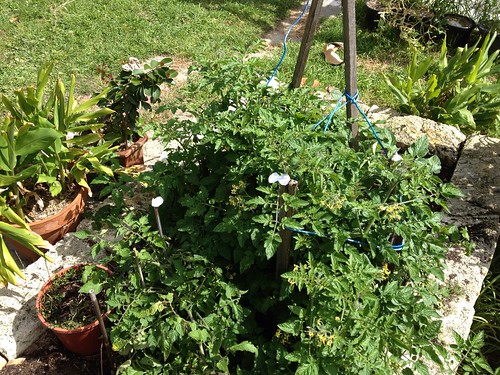When I was about twelve, Mum and Dad bought a small berry farm in our home town and I recall many asummer's day picking strawberries, loganberries, boysenberries and raspberries! Picking strawberries is especially backbreaking. But, I absolutely love strawberries, they are one of my favourite fruits. Did you know they are part of the Rose family (
Rosaceae)?
We have some in hanging baskets, one of which has continued to fruit over the winter months, which is amazing! Strawberries tend to put out runners each year and the main plants can last up to three years before you need to replace them, although the fruit gets smaller with each year. I transplant them each year and have enough now to do just that this time around, which is great!
It's really easy to
transplant strawberries. Usually you would do this towards the end of winter (particularly in Perth's climate) as the plants are usually dormant in the cold weather.
 |
| Pull apart plants and remove old leaves and dirt from roots. |
First, dig out the clump of strawberries plants and gently pull each plant away from the others and remove the dirt from the roots by swishing in a bucket of water. You can add a very small amount of seaweed solution to the water (but no more than a capful). If the roots are especially long, trim them with a sharp knife or secaters.
Next, pull away the outer leaves (those that come away easily is usually enough) so that you have about four left on the plant.
Now you are ready to plant! Strawberries are susceptible to mould and mildew so it's a good idea to plant them in a sunny, well drained position. You can create a mound of soil on which to plant your strawberries to increase the airflow and drainage around the plants. Some gardeners use black plastic to stop weeds from crowding the plants - we did as our berry farm was a commercial operation, which also housed trickle irrigation to minimise mould and mildew. For the home gardener, mulch does just as good a job (and doesn't fry your soil either).
Make sure your soil is beefed up with good compost and blood and bone, and add some rock dust too if you can get some. Strawberries like a slightly acidic soil.
 |
| Space plants for good airflow and apply a good layer of mulch. |
Finally, to plant, simply make a hole with your trowel handle large enough to ensure the roots have plenty of wriggle room and drop in your plants. Cover to the small crown and firm down the soil. Water in well and apply a good layer of mulch (this helps to keep your fruit clean too).
You should check your plants daily for the first couple of weeks just in case some don't take. Replace these with other plants. Keep them watered regularly.
 |
| Water in well with a weak seaweed solution. |
If you want a decent strawberry crop, you probably need at least ten
plants minimum. We have three hanging baskets plus a planter box.
Baskets and planters are also a good way to minimise snails and slugs if
they are a problem in your garden - they LOVE strawberries!
If you are into
companion planting, lupins, beans and borage are good helpers for strawberries as they feed the soil and attract pedatory and pollinating insects such as bees and wasps.
Happy gardening!







